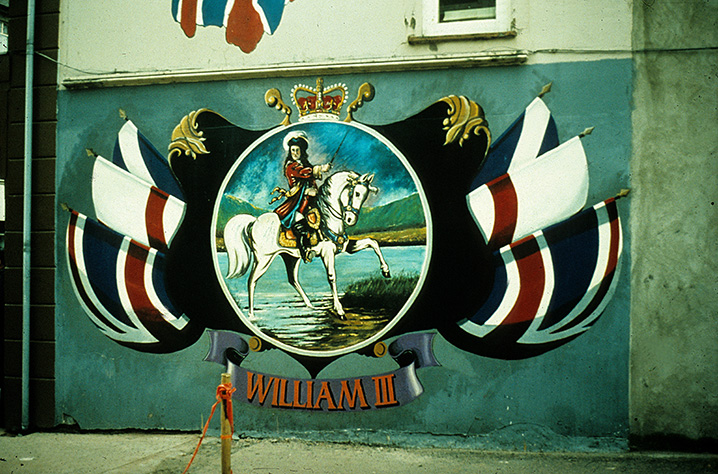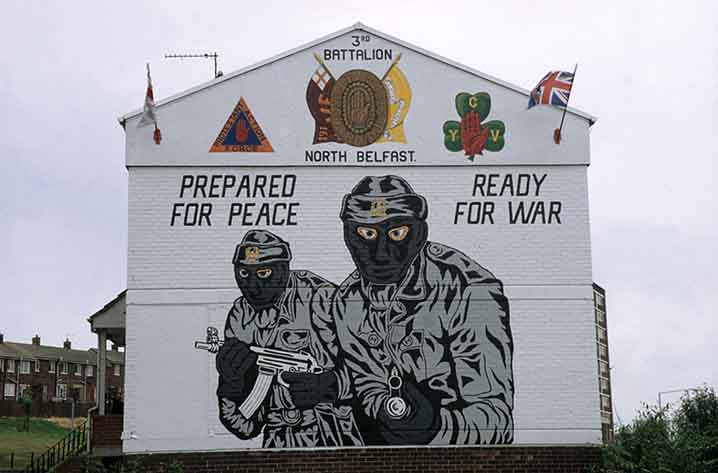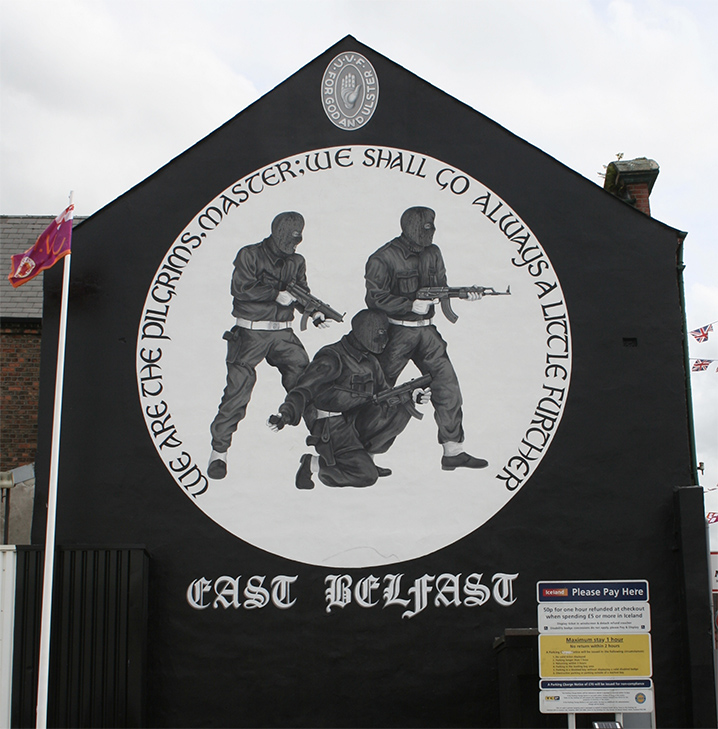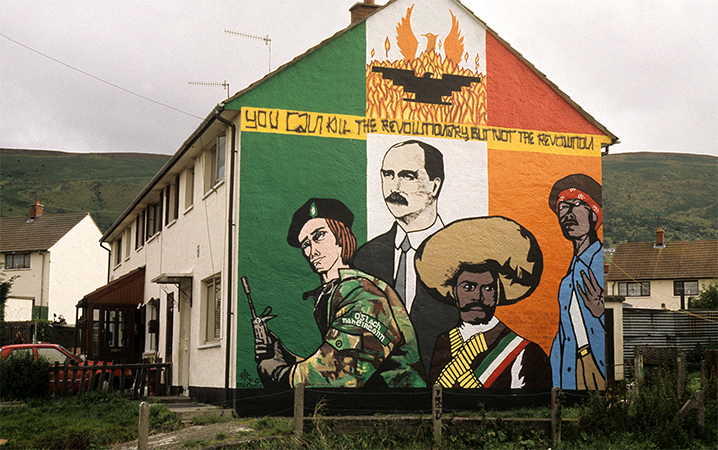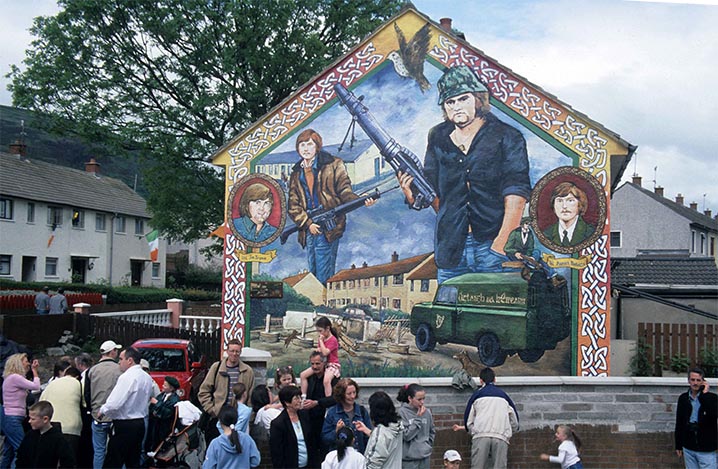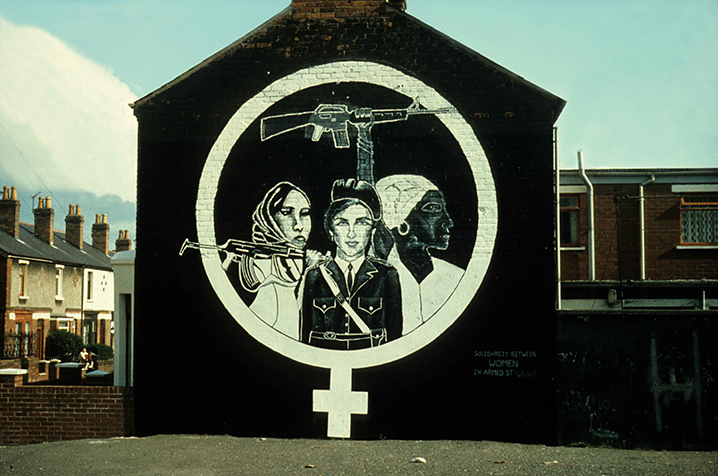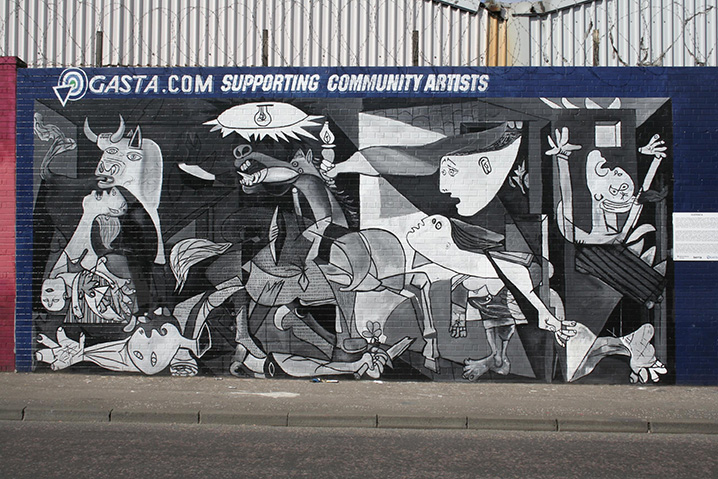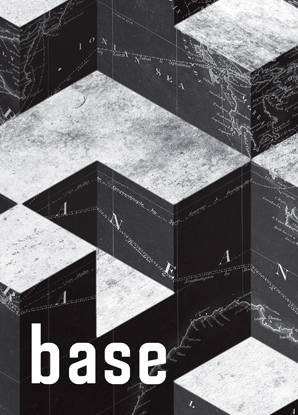The political mural tradition in the northern part of Ireland is over 100 years old. For most of that time, it was confined to one community and overwhelmingly to one theme: the victory of King Billy over King James at the Battle of the Boyne in 1690. This victory copper-fastened the Plantations of the early 17th century and told the settlers that, with a Protestant king at the helm, they were here to stay. Incidentally, this is a reassurance that they have needed constantly in the centuries since, leading one prominent cleric to remark that, for all that they are descended from settlers, they are a remarkably unsettled people. Before the state of Northern Ireland was created in 1921 and with greater intensity afterwards, the Unionist population celebrated Billy’s victory on the anniversary of the Battle of the Boyne, July 12th, with bunting, flags, arches, marches and, beginning in 1908, murals. For the next 60 years the bulk of the murals on the streets of Belfast and other northern towns ritualistically displayed King Billy on his white horse, the victorious general and the bedrock of Protestant ‘freedom, religion and laws’ in Ireland.
With the recent conflict in the North from the late 1960s, the mural scene was transformed. Nationalists began marching for civil rights and were met by an authoritarian one-party Unionist state that was resistant to change. In a short time the guns came out and a three-decade long conflict ensued. Contrary to some views from outside the North, this involved three protagonists: militant Republicans (in particular the Irish Republican Army, IRA), militant Loyalists (especially the Ulster Volunteer Force, UVF, and Ulster Defence Association, UDA) and the state forces (British army and local police, the Royal Ulster Constabulary, RUC). As the bullets flew and the bombs exploded, working class areas became increasingly militant and often besieged. Every side was involved in a battle for hearts and minds and murals began to play a key role for two groups of protagonists. The murals in working class communities propagated the Republican or Loyalist message: mobilising support, confirming ideology, comforting the afflicted and calling on waverers to join the struggle.
Not surprisingly, in this context, many of the murals were unapologetically military in content. Republicans painted few murals before 1981, but with the hunger strike of Republican prisoners of that year, in which ten prisoners died, there was a sudden emergence of mural painting in Republican areas, calling on people to support the prisoners and their demands for, in effect, prisoner of war status. Meanwhile, with direct rule from Westminster, Unionists came to feel increasingly estranged from British policies and goals, and in that situation Loyalist paramilitary groups were the vanguard of a militant assertion of identity. In the mid-1980s the Loyalist commanders took over control of the walls in their respective areas; from then until the present, mural painting in loyalist areas is at the behest of or, at very least, with the permission of the local UVF or UDA commander. Not surprisingly, these commanders were happiest with murals which were advertisements for their organisations. Thus, a proliferation of murals depicting hooded men with guns emerged in loyalist areas.
Republican areas were markedly different. For a start, there were sometimes murals of women with guns. But the difference went much deeper; IRA commanders never sought a monopoly on mural painting in their areas. Admittedly there were numerous depictions of armed IRA members, to the point where the stranger walking into an area might be forgiven for not knowing whether it was a Republican or a Loyalist enclave. This was not the case for locals; the segregation, physical and psychological, between communities has been so profound that no local needed a mural to be informed of the complexion of the area, especially if one had the misfortune of straying into the wrong area.
That said, Republicans had an advantage. Loyalism is a relatively narrow political ideology, seeing itself as the defender of British Ulster against all assaults, real or imagined. Coupled with the military monopoly of mural painting, this does not make for a rich palette, either in terms of subject matter or artistic expression. Republicanism is a broader church. It can look to its own history, going back centuries, of resistance to colonialism and imperialism.
It can scope the wider history of Ireland for instances of repression and resistance. Celtic mythology can be a rich seam to be mined for ideas and images. Republicans can look around the world and identify with what they see as similar struggles in South Africa, Palestine, Kurdistan, the Basque Country, Cuba, etc. and that resonance allows them to paint messages of support. In addition, as the peace process advanced from the mid-1990s, their identification with the possibilities of change offered by the process allowed space for commentary in murals on their aspirations and their frustrations regarding the rate of progress.
This ensured a greater range of themes and styles in Republican murals than has ever been the case in Loyalist areas. As Loyalist muralists showed a preference for the British colours of red, white and blue and, more recently, have painted numerous murals in black, white and shades of grey, the vibrancy of colour in many Republican murals is sometimes the most obvious badge of difference, even before one begins to consider the content and the message.
The murals of each side have dealt with the peace process in different ways. Because of the range of themes they could explore, Republicans had the luxury of being able to reach an important conclusion with the signing of the Good Friday Agreement in 1998. They decided that, with two exceptions, there would be no more guns in murals. One exception was in relation to memorial murals to dead comrades, the other in relation to historical murals. In both cases, the message was clear to local audiences: these are not contemporary guns. Murals still appear on history, mythology, international connections and local current affairs so that there is no apparent diminution in the number and vitality of Republican murals. This was not an opening available to Loyalists. They had metaphorically painted themselves into a corner by monopolising the imagery of armed conflict, which meant that to abandon guns in murals would be to threaten the very continuation of their mural tradition.
There was, of course, one obvious solution: return the walls to the wider Unionist community so that the aspirations, fears and needs of the whole community would find expression there and not simply the obsessions of the armed section of that community. There has been some progress in that regard, not least as a result of a government scheme, the Re-imaging Communities Programme, which pays for the replacement of the more offensive, usually militaristic, murals. The downside of that is that the programme in effect works on the principle, ‘Don’t mention the war’; the need to be inoffensive results in murals which are frequently bland.
The difference between Republican and Loyalist murals in this respect is highly significant. The Loyalist muralists’ reluctance to remove the guns speaks volumes of the Loyalist paramilitary groups’ attitude to the peace process. Conversely, the Republican ability to remove the guns from their murals is symbolic of their relation to the peace process. Put simply, Loyalist paramilitary groups have been often, at best, ambivalent about the peace process, while, in a remarkable turn of events, Republicans, although still anti-state, are among the most ardent supporters of the state institutions which have emerged from the peace process.
The apparent anomaly can be explained. As historical underdogs, Republicans see change as opportunity. They had a military strategy based on the notion of a ‘long war’ and they have been able to transform this into a commitment to a ‘long peace’. In other words, their strategy is based on exploiting the opportunities and contradictions of the peace process to inch them inexorably towards their goal of a united Ireland. Loyalists, on the other hand, tend to see change as threat: threat to their hegemonic position within the small theatre that is Northern Ireland, threat to their culture of marching and flag-waving, threat to their very existence as British subjects, loyal to the monarchy and committed ad infinitum to the union with Britain. One position leads to imaginative expression, visual and otherwise, while the other position is more confined.
There are a few riders which need to be added to this picture. First, there are Republicans who have not abandoned the guns. The so-called ‘dissidents’ who disagree with the mainstream Republican commitment to the peace process spearheaded by Sinn Féin, like Loyalists see the peace process as a threat, in this instance to the possibilities of achieving a united Ireland. Second, it needs to be reiterated that Loyalism is only part of Unionism. The wider Unionist community has historically and currently been able to boast of trade unionists, feminists, environmentalists and others; what these groups could paint on their walls if that space was available remains to be seen, but it is unlikely to be portrayals of armed, masked men.
Belfast in particular has a vibrant mural scene which attracts countless tourists. Apart from the Republican and Loyalist murals there has been the recent and belated emergence of street art, some of which can match the best of international practice. There have also been a few tentative explorations with Loyalist and Republican muralists working jointly on projects. The first major example was a 2007 reproduction of Picasso’s Guernica. Significantly, this was painted in a Republican area given the feeling of all involved that a Loyalist muralist painting in a Republican area was likely to be in a safer situation that a Republican in a Loyalist area. It would be a mistake to presume that such joint endeavours represent the future of mural painting in Belfast. But suffice it to say that the century-old tradition is still alive and well, stuck in a rut in some ways, but in other ways, exploring new expressions.
by Bill Rolston | billrolston.weebly.com
